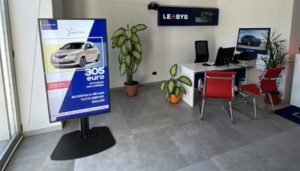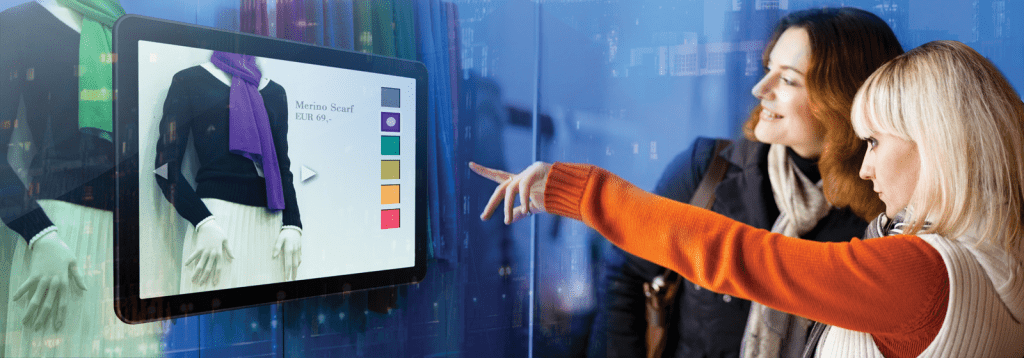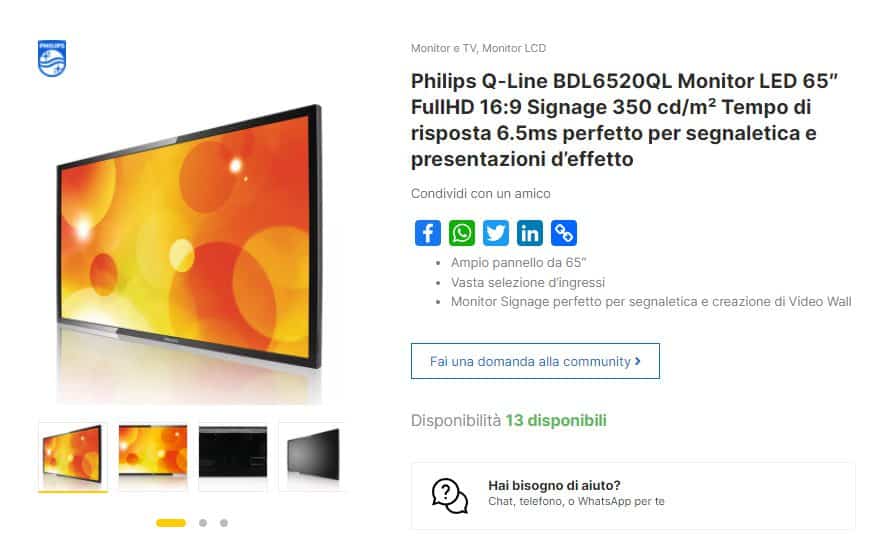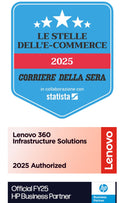Digital signage: what it is, how it works, how it wins customers over
Advertising evolves and thanks to new technologies it becomes dynamic, welcome to the era of Digital Signage.
What exactly is Digital Signage? 
As can be seen from the translation from English, with Digital Signage the entire phenomenon of digital signage is highlighted. A new advertising technology, which after having achieved success overseas (who doesn't remember the scenes of Times Square lined with screens?) has also arrived in Italy.
Installed near the point of sale or in public spaces, regardless of whether outdoors or indoors, Digital Signage is also known in Italy as "video poster", digital signage or digital signage.
How does it work?
There are two possible operating principles of Digital Signage. On the one hand we have video projection, with the signal generated by dedicated video projectors placed in public or private places. Alternative option is to use electronic screens (LCD or plasma screens). In both cases, the plus of this technology is the very rapid speed of updating the message and the possibility of varying it based on the times, days and possible passages of people in front of it. Digital Signage attracts attention, thanks to bright and bright messages and images, which vary often and which can also include videos.
 Characteristics of Digital Signage
Characteristics of Digital Signage
The possibility of introducing a high variability of the message combined with the sharing of the medium makes Digital Signage usually more efficient and at the same time convenient compared to traditional signage.
The quality of the message transmitted is also considerably higher than that which can be delivered by traditional signage. Texts, static images and videos. The quality of Digital Signage can reach that of television shows.
Another advantage of Digital Signage compared to traditional advertising is given by the possible synchronization of the signage, the message transmitted through this advanced advertising system can in fact be synchronized and managed remotely via a network connection or remote configuration.
Digital Signage is also highly appreciated because it can be used in a "mixed formula", thus alternating advertising with useful tourist or institutional information. Double communication can also take place in other formulas derived from television, from subtitles to pop-ups and displays with dynamic windows next to the main one.
Digital Signage applications
There are various uses for which Digital Signage is designed and used. In particular:
- Informative: the main purpose is to provide information on departure and arrival times or possible delays. In this field, Digital Signage is perfect, because thanks to its possible real-time updating it improves the efficiency of communication. Existing applications include signs in trains and airports, but also those in motorway service areas that show traffic status. The typical use in this case is the hybrid formula, which mixes informative news with entertainment, advertising and generic news.
- Promotional: usually installed inside large shopping centers. It allows you to keep the customer informed about promotions and discounts in the facility's stores. The total flexibility of this solution also allows it to be used by time slots. Advertising thus changes based on the customer's needs. The typical case is the use in the promotional food sector, with advertising that advertises the correct meal or type of offer based on the time.
- Experiential: the customer is informed about what is happening in the restaurant at that exact moment. The typical installation is that of a restaurant or cocktail bar, in which Digital Signage mixes advertising with glimpses of the preparations and "behind the scenes" in real time.
- Influencing functions: more indoor signage, the purpose of which is to prolong the customer's stay by encouraging them to discover new proposals and offers. This message is also conveyed to the location, time and many other factors, with the aim of interacting and guiding the customer.
- Retail design: Digital Signage is used within single-brand stores or innovative museums to show pieces of history of the brand and its protagonists. Classic example in Italy are the museums of football teams, in particular the Juventus Museum, where this technology is used to show the most exciting moments of the brand, of a trophy or of a single player.

Hardware
When Digital Signage is composed of displays , LED or plasma technologies are normally used. Based on the placement of the screen, the target distance from which the customer is considered to see the message and the ambient brightness, the best solution will be chosen.
The first parameter that is considered is usually that of resolution , which sees the massive use of Full HD and UHD monitors .
In addition to resolution, another fundamental parameter is brightness . The value chosen in this case is strongly influenced by the intended location. Outdoor installations or those affected by intense natural light will in fact require very high brightness to be visible. Brightness that must be controllable to avoid the effect of over-lighting at night. An equally important parameter linked to that of brightness is the Haze Level , i.e. the degree of reflection of the monitor itself.
Another important technical factor is that of contrast , which, especially in conditions of strong ambient light, must be as high as possible.
Finally, based on the location it is necessary to check the robustness and resistance to atmospheric agents , fundamental factors when the monitor is installed outdoors.
 Software solutions
Software solutions
These communication and advertising solutions are usually connected to a network, through which a communication or designer agency can transmit the audio/video message. To do this, dedicated software, called Content Visual Management, is used . These applications allow you to remotely control a single screen or the entire network.
The software allows complete control of what is shown, also allowing it to be managed in a personalized way. In fact, through the application you can define a schedule based on the time slot, the position, the target audience and many other factors.
Remote control also allows you to choose which content to publish, from classic information and advertising content to more interactive content, such as feeds taken from social media for the creation of dynamic "video walls".
Digital Signage and IoT
The factor that brings Digital Signage "light years ahead" compared to traditional signage is that of interactivity. Digital Signage is in fact connected and can be interactive, thus allowing the customer to interact with the screen. The classic example is that of shops or airports, where reading the boarding pass, a barcode or a QR code allows the display of precise, updated and dedicated information.
OUR MONITOR SIGNAGE PROPOSAL








